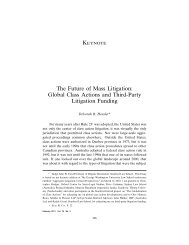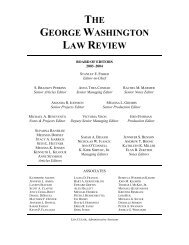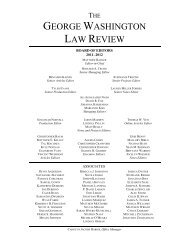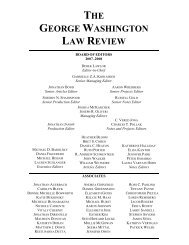View PDF - The George Washington Law Review
View PDF - The George Washington Law Review
View PDF - The George Washington Law Review
Create successful ePaper yourself
Turn your PDF publications into a flip-book with our unique Google optimized e-Paper software.
906 <strong>The</strong> <strong>George</strong> <strong>Washington</strong> <strong>Law</strong> <strong>Review</strong> [Vol. 78:870<br />
straints.” 170 However, Radford’s far-reaching assertion is unsupported.<br />
Those who argue that the “substantially advances” test has no<br />
place in takings jurisprudence, whether as a stand-alone determinative<br />
test or as factor in a balancing test, are not harboring an “anachronistic<br />
yearning for expansive governmental authority,” but instead are<br />
objectively interpreting the law:<br />
It is obvious that property rights advocates have asserted expansive<br />
readings of the Takings Clause because they are dissatisfied<br />
with the well-worn traditions of judicial deference in<br />
due process cases. <strong>The</strong>y hoped to find in relatively immature<br />
takings doctrine sufficient maneuvering room to support the<br />
kind of robust judicial intervention in economic policymaking<br />
not seen since the era of Lochner. 171<br />
<strong>The</strong> use of a deferential standard of review for due process claims<br />
may very well provide insufficient protection for property owners, but<br />
it is not a justification for applying a heightened level of means-ends<br />
analysis in regulatory takings jurisprudence. Regardless of the potential<br />
benefits, a regulatory takings analysis that focuses on whether regulations<br />
are functionally equivalent to the government’s direct<br />
appropriation of land is not the place to redress the alleged deficiencies<br />
of rational basis due process review. Means-ends analysis should<br />
remain distinct from a regulatory takings claim. 172<br />
Instead, the problems associated with such a lenient due process<br />
standard should be regarded, if anything, as evidence that the Court<br />
should abandon the extremely deferential rational basis standard currently<br />
applied in zoning-regulation due process challenges. Justice<br />
Kennedy’s concurrence in Lingle appears to leave open the possibility<br />
of the Court applying an intermediate standard of review in future<br />
due process challenges. In Lingle, Kennedy cross-references his concurring<br />
opinion in Eastern Enterprises v. Apfel, 173 where he applied a<br />
more searching form of rational basis review. 174 Justice Kennedy’s<br />
170 Radford, supra note 57, at 401.<br />
171 Echeverria, supra note 34, at 199.<br />
172 “Lingle emphatically rejected any heightened scrutiny for property regulation warning<br />
that it would lead to evaluation of a ‘vast array’ of statutes and ordinances and force courts to<br />
‘substitute their predictive judgments for those of elected legislatures and expert agencies.’”<br />
Byrne, supra note 162, at 480 (quoting Lingle v. Chevron U.S.A. Inc., 544 U.S. 528, 544 (2005)).<br />
173 E. Enters. v. Apfel, 524 U.S. 498, 539 (1998) (Kennedy, J., concurring in the judgment<br />
and dissenting in part).<br />
174 See Lingle v. Chevron U.S.A. Inc., 544 U.S. 528, 548–49 (2005) (Kennedy, J., dissenting)<br />
(citing E. Enters., 524 U.S. at 539 (Kennedy, J., concurring in the judgment and dissenting in<br />
part)). In Eastern Enterprises, Justice Kennedy, speaking for himself, found it was one of the<br />
“rare instances” where a statute did not meet the “permissive standard[s]” of due process. E.









